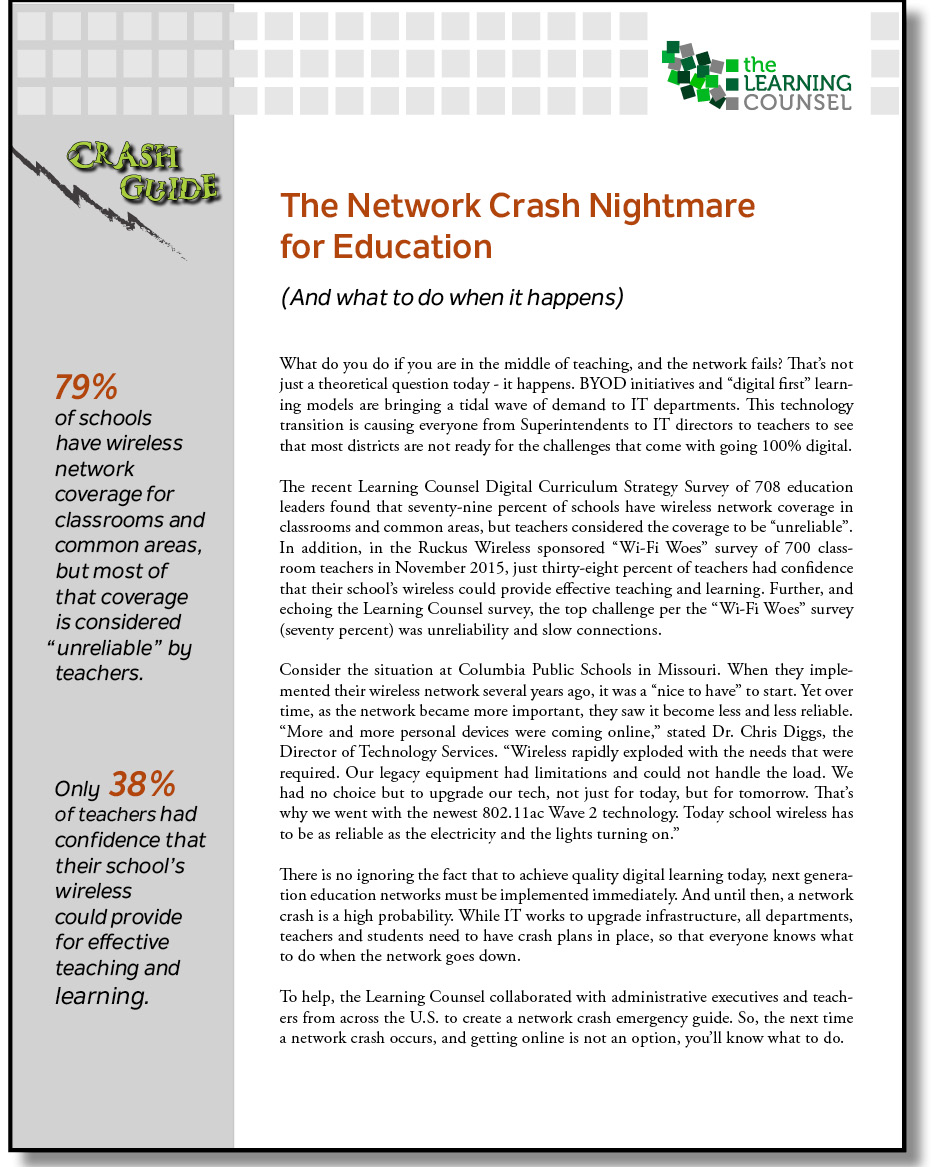What do you do if you are in the middle of teaching, and the network fails? That’s not just a theoretical question today - it could, and does, happen. Having networks that are highly-available and highly resilient to meet even the greatest demands of students and teachers still keep Superintendents and their Chief Technology Officers up at night. As I have traveled around the country meeting with hundreds of these executives in the last four years as part of the Learning Counsels’ Digital Curriculum Discussions, the concern over the real preparedness of the district for a network outage looms large.
Moving towards more digital curriculum and content means greater dependency on the networks ability to meet demand. Even with the growth in use of digital curriculum and content, highly-reliable and highly-resilient connectivity in the classroom is not a necessarily common.
The recent Learning Counsel Digital Curriculum Strategy Survey of 708 education leaders found that seventy-nine percent of schools have wireless network coverage in classrooms and common areas, but teachers considered the coverage to be “unreliable”. In addition, in the Ruckus Wireless sponsored “Wi-Fi Woes” survey of 700 classroom teachers in November 2015, just thirty-eight percent of teachers had confidence that their school’s wireless could provide effective teaching and learning. Further, and echoing the Learning Counsel survey, the top challenge per the “Wi-Fi Woes” survey (seventy percent) was unreliability and slow connections.
Consider the situation at Columbia Public Schools in Missouri. When they implemented their wireless network several years ago, it was a “nice to have” to start. Yet over time, as the network became more important, they saw it become less and less reliable. “More and more personal devices were coming online,” stated Dr. Chris Diggs, the Director of Technology Services. “Wireless rapidly exploded with the needs that were required. Our legacy equipment had limitations and could not handle the load. We had no choice but to upgrade our tech, not just for today, but for tomorrow. That’s why we went with the newest 802.11ac Wave 2 technology.”
Like Columbia, school I/T administrators we've spoken with from every corner of the country, are experiencing similar challenges. To help, the Learning Counsel collaborated with executives, teachers and networking professionals to summarize the leading “steps for preparedness” that should be considered.
We hope this will help to ensure your school or district’s “digital highway” is ready to support the needs of ‘student drivers’ and teachers on any device— laptops, Chromebooks, tablets, phones or whatever best serves them, at any time, in any location, with no network interruption.
Review Steps for Your Network Readiness:
- Is your network highly available - like switching on a light or running water from a tap? To avoid downtime, you should consider implementing redundant wireless controllers, or cloud-managed infrastructure, for example. Especially for state testing week, this is a must—let alone blended learning curriculum.
- Is your network ready for high capacity? Imagine 1:1 Chromebooks in multiple classrooms all streaming HD video or screen mirroring, while the smartboard, printer, AppleTV and other headless devices use wired connections. If your network couldn’t handle that, then it is time for a change. To start, measure against the ConnectED goal of 1-3 Mbps per student as a minimum.
- Consider the rule, ‘more than you need’ when upgrading networks - it is more fleeting than you expect. More devices, more applications, and more multimedia continues to trend. Therefore, deploying 802.11ac Wave 2 access points with stackable 2.5GbE edge switches may see like overkill now, but within 3 years may be ‘just enough’ for many.
- A great network doesn’t get the job done without hassle-free access. Do you have a way for students and other users to quickly and securely connect to the Internet without IT help, and without teachers being an extension of the help desk? A simple and easy-to-manage onboarding solution can help ensure students spend more time learning, and less time being frustrated with their devices.
- Even with the best laid plans (or cable), things can go wrong. Consider your IT staff’s ability to speedily restore the network. Do you have centralized wireless management with mobile control? A mobile app to manage your network can be invaluable, as it’s always on, regardless of whether you’re driving, or simply walking down the hall when a network alarm occurs.
There is no ignoring the fact that to achieve quality digital learning today, next generation education networks are a must. And until then, a network crash is a high probability. While IT works to upgrade infrastructure, all departments, teachers and students need to have crash plans and non-internet demanding teaching options in place.
The complete
 Network Crash Guide is available for free download.
Network Crash Guide is available for free download.











